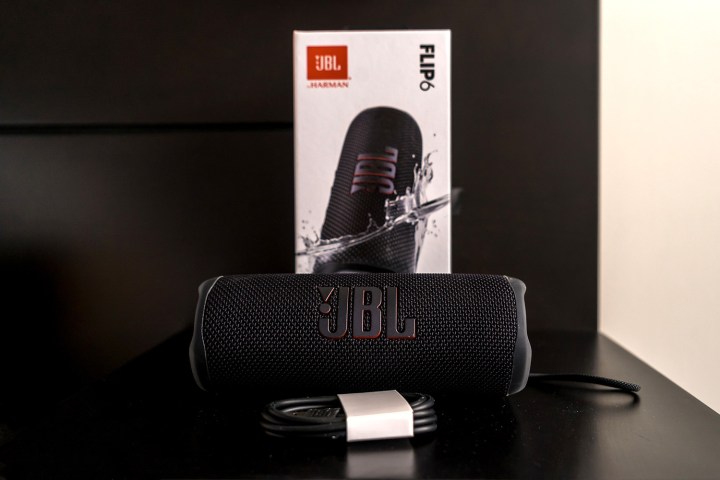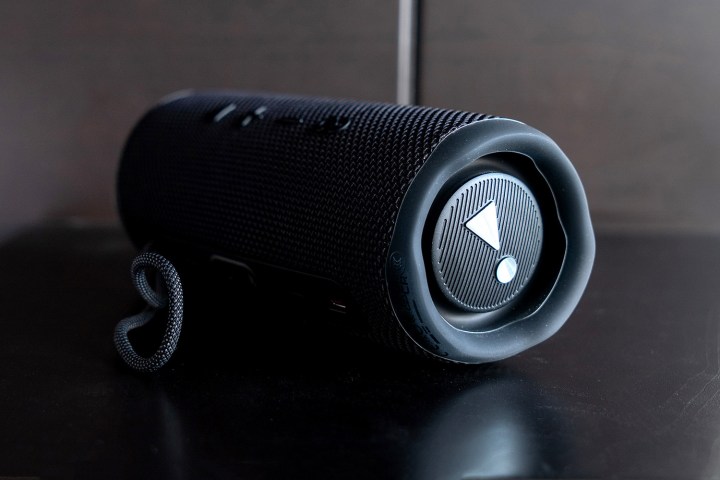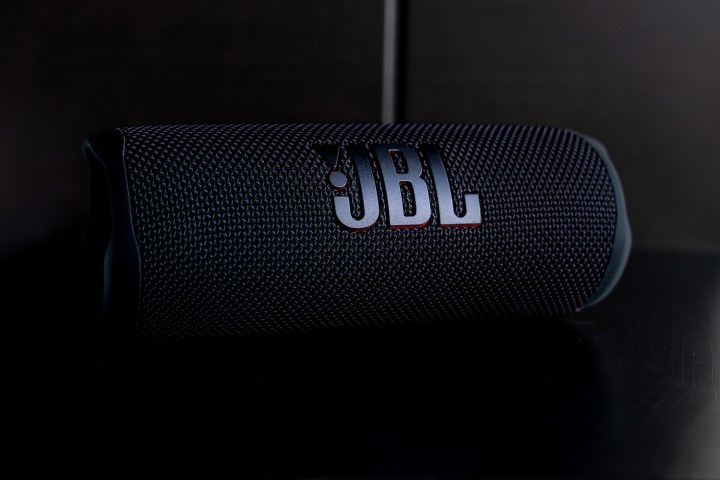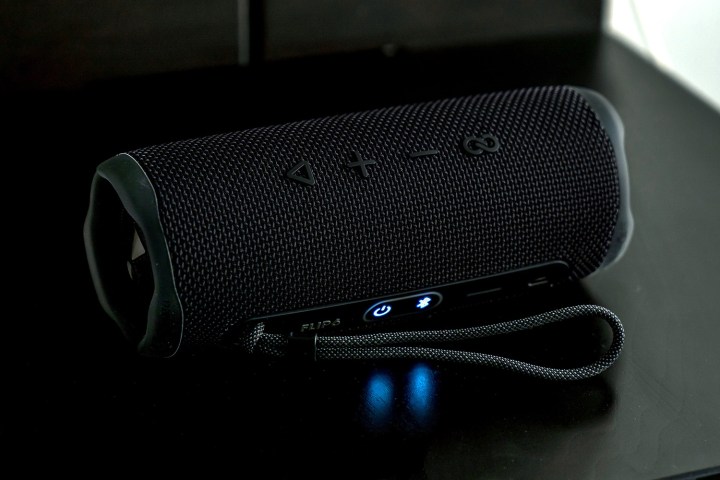- Solid build quality
- Loud and clear sound
- Lightweight and portable
- Excellent water and dust protection
- EQ offers some sound tweaking
- Works with JBL Portable app and PartyBoost
- Can't stereo pair with non-Flip 6 JBL speakers
- Doesn’t work as a speakerphone
- Not drastically different from Flip 5
Bluetooth speakers are often a predictable lot, where functionality and portability complement how well they sound. But different speakers are designed for different situations. When it comes to the crowd-pleasing type, JBL is all over it. Its Flip line fits that description to a tee, and the company continues to bring out new models on an almost annual basis.
For that reason, don’t expect a surprise from the JBL Flip 6. If you know what the Flip speaker lineup is all about, you know you will get ample bass and some loudness to boot. Both are obvious once you start the music, so what are the other benefits coming from the few extras JBL threw in?
What’s in the box?

There’s not much to unbox with the Flip 6. JBL could look to slim down its packaging, or at least print an image of the speaker’s true dimensions on the side, so as not to give the impression it’s bigger than it actually is. Other than the speaker itself, you’ll find a USB-C charging cable and quick start guide.
Design

You get the same cylindrical design and, for the most part, similar dimensions a its predecessors. JBL shaved just a little off the height (7.0 inches), width (2.6 inches), and depth (2.8 inches) to make it a tad smaller, albeit with effectively the same weight. Not that it’s heavy at 1.21 pounds — it actually feels just as portable, letting you take it with you wherever you go.
That includes around water thanks to an official water and dust resistance rating. Unlike previous Flip versions, JBL got an IP67 rating for this one, improving upon the Flip 5’s IPX7 rating. It’s perfect if you want to sing along in the shower, listen to a podcast in a relaxing bath, or make a splash around the pool. Let’s not forget the beach, either, as the Flip 6 holds up just fine in saltwater and sand, making it a good option for any number of outdoor activities.
JBL got an IP67 rating for this one, improving upon the Flip 5’s IPX7 rating.
The durability extends to the rubberized bumpers surrounding the passive radiators on each end. JBL carried that same design principle over here, and the bumpers continue to play a big role in protecting the other components. Much of the rest of the Flip 6 represents an aesthetic change on the outside, like the bigger JBL logo on the front and more textured fabric on the body. A rubber sliver at the bottom keeps the speaker from rolling, while also tilting some of the audio upward for a more spacious sound profile.
JBL also addressed the lack of a lanyard in previous versions by integrating one in the Flip 6. By integrated, I mean that it’s already tied up for you, and in case you ever lose it, you could realistically replace it with another one.
Wisely, JBL didn’t change the control layout, using the same raised buttons that, while not backlit, are easy to feel and be accurate when you want to play/pause music or control volume. Power, Bluetooth, battery level indicator, and USB-C charging port also return in the rear.
Setup and configuration
It was easy to pair the Flip 6 via Bluetooth out of the box as it automatically enters pairing mode. It’s just as easy to put it in pairing mode again later by holding down the speaker’s Bluetooth button until it flashes. It connects to one device at a time and JBL didn’t equip it with a microphone, so the Flip 6 has no speakerphone functionality. This thing is about playing audio, not making phone calls, which is a glaring omission at this stage of the game in the industry.
One thing JBL did change with the Flip 6 is letting it access the JBL Portable (formerly Connect) app for iOS or Android. You can use it to update the firmware and adjust the modest number of settings. The big standout to me was the EQ, something previous Flip speakers didn’t have. It’s hardly intricate, with basic sliders for bass, mids, and treble, but it does mark a shift toward giving the Flip 6 a measure of audio control.
PartyBoost is back again, though not without some guardrails. I could use the Party mode to wirelessly connect it with other compatible JBL speakers to simultaneously play the same audio. You can also create a stereo pair if you own or a friend own another Flip 6 (both speakers have to be the same model). I tried to pull it off with a Flip 5 and got nowhere.
Sound quality

It’s hardly a surprise that bass stands out in the overall sound signature. JBL dials it up with each successive iteration. In this case, it’s less about ramping up the bass by default because you can adjust it through the Portable app’s EQ. What’s interesting is that the mids and highs make a bigger impact in the sound signature. We’re not talking something audiophiles will love, but it’s hard not to like the results, such as they are.
The Flip 6 gets loud — again, par for the course for a speaker like this. It’s the resonance at louder volumes that impressed me. Just when I expected distortion to set in and start crackling the highs or lows, it maintained a stable sound that I grew to like even more over time.
The Flip 6 gets loud — again, par for the course for a speaker like this.
Part of that has a lot to do with context, meaning I often used the speaker as I moved around my place. Whether I was taking a shower, cooking a meal, or listening to tunes while working, it became a convenient staple in my day-to-day routine. Whether it was various genres of music, or long podcast episodes, I appreciated the Flip 6 for what it could deliver.
If you are a fan of bass-heavy genres, I don’t think you’ll be disappointed in the output here. It’s deep and rumbling, with just enough detail in the mids and highs for decent balance. Pretty much any playlist of Top 40 and party hits will go over well with a small crowd when this thing pumps them out.

Battery life
JBL claims the Flip 6 can last up to 12 hours per charge, but I never reached that at any time. It depends on how loud you go, but I was in the range of about 8 to 10 hours, which isn’t bad. That’s plenty of time for a trip to the park or beach, or hanging out at the pool. Plug it in with the USB-C cable, and you can keep the music playing that way, especially if you have a portable battery pack to help out.
Our take
At $130, the Flip 6 feels like good bang for your buck. You get a speaker that’s highly portable, yet packs a big enough punch to get loud when you need it. Its extra durability makes it safer and more useful in sandy and tougher environments, which certainly doesn’t hurt, either. Plus, you get a handful of colors to choose from: Black, blue, red, gray, and teal.
Is there a better alternative?
JBL isn’t abandoning the Flip 5, which is arguably just as good for most situations, but if you are to go that route, wait until the price drops. Ultimate Ears charges more at $150 for similar size and toughness in the Boom 3, except you also get a more spatial sound because of how the speaker wraps around the body. To get that spatial effect with serious toughness, you’ll pay the same $150 to get the Outdoor Technology OT-2800-B Turtle Shell 3.0, which offers the same level of water (but not dust) resistance.
If your budget allows and you want a whole-home music ecosystem to go with your Bluetooth speaker, you might also think about the Sonos Roam. It does both Bluetooth and Wi-Fi, plus easy voice commands and wireless charging, and you get it all for $179.
How long will it last?
JBL’s speakers have a pretty good track record, and the Flip 6 was made to last. You do need to treat it right to ensure its longevity, like rinsing off sand and salt, for example. Keep it clean and it should keep playing for years. JBL offers a one-year warranty to cover the speaker from damage, but not for all instances of water damage.
Should you buy it?
Yes, if you need a speaker this size that prioritizes loud, clear sound, and you’re cool with not having a speakerphone inside. If you already have a Flip 5, you probably don’t need to take the plunge, unless you really feel you want the few new features available.








